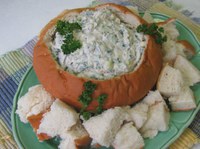Prairie Fare: What’s Your Game Plan for Sports Snacking?
(Click an image below to view a high-resolution image that can be downloaded)
By Julie Garden-Robinson, Food and Nutrition Specialist
NDSU Extension
“What do you think about the teams in the Super Bowl?” the cab driver asked me. “Do you have a favorite?”
Oh no, I thought to myself.
Fortunately, I happened to be paying a slight amount of attention to the playoff games. My husband likes to watch football and text with our son during the games. I could name the teams, anyway.
To divert attention from my lack of sports trivia knowledge, I asked the cab driver questions. He liked to talk. He travels all over the country to watch games, including the last several Super Bowls.
I decided that driving a cab must be lucrative, or he is independently wealthy.
He was a walking encyclopedia of sports trivia. Of course, he could have told me almost anything. I did not fact-check him with my phone.
The 30-minute ride to the airport passed quickly.
When I returned to my campus office, I had an email about doing a radio show on Super Bowl snacks. I know a lot more about food than football teams.
We can apply much of the following information to most social situations, whether you invite friends over to watch movies, play card games or watch any type of sport on TV.
“Snacking” sometimes has a negative connotation. Snacking can have positive health effects. You can help people fill the nutrition gaps in their diet if you have a game plan for the food you serve.
First, remember food safety all the way from the grocery store or restaurant to your home.
Be sure to avoid cross-contamination. Wash or use different cutting boards and knives for cutting raw meat and before cutting fruits and vegetables. Cross-contaminating ready-to-eat foods with juices from meat is a common food handling error, which can cause serious foodborne illness.
Be sure to keep track of the amount of time your food is at room temperature, whether it is a meat and cheese tray or a platter of cut fruit. Perishable food usually is high in moisture and protein; they can be held safely no more than two hours according to the U.S. Department of Agriculture. Provide tongs or serving spoons.
To keep foods palatable and at safe temperatures, keep hot foods, such as chicken wings or meatballs, hot on your serving table. You can use a slow cooker on low as a hot-holding unit to maintain their temperature at 140 F after cooking thoroughly.
See the food safety information at www.ag.ndsu.edu/food for more information.
By the way, serving fruits and vegetables as part of your snack buffet is an excellent idea. Fruits and vegetables add flavor, color, variety and nutrition. They are naturally low in calories, sodium and fat, so they can counterbalance higher-calorie options. Fruits and vegetables provide vitamins such as vitamins A and C, along with minerals such as potassium.
Serve some whole-grain foods, too. For example, popcorn is a healthful whole-grain food. Go easy on the butter and salt to keep the calories and sodium low.
If you serve pizza, try a thinner-crust option and veggie toppings in addition to your favorite meats to trim some calories.
Provide salsa with whole-grain chips. Try making fresh salsa with ripe tomatoes, onions and peppers, or compare the nutrition among various brands of premade salsa.
Keep your protein choices healthful. Have some hummus and/or lightly salted nuts. If you make meatballs, choose lean or extra-lean beef or pork. Instead of deep-frying foods, use an air-fryer or your oven to make homemade chicken wings or nuggets.
Try chili as an excellent “game day” food. Add some extra beans, such as kidney or black beans, to increase the fiber and folate. Drain and rinse canned beans before adding to your creation to reduce about 40% of the sodium.
How about alcohol? Alcohol provides calories without nutrition; however, if you enjoy beer or other alcohol-containing beverages, consider drinking a glass of water in between cans or bottles. Keep the empty containers in front of you so you do not lose track.
Be sure to provide alternative beverages such as water and other lower-calorie beverages for those who are underage or choose not to indulge.
Here’s one of my favorite dip recipes. Using lower-fat versions of sour cream helps reduce calories in dips.
Party-size Spinach Dip
1 (10-ounce) package frozen, chopped spinach, thawed and drained
1 (1.5-ounce) package dry vegetable soup mix
1 (8-ounce) carton fat-free sour cream
1 cup mayonnaise (try olive-oil based for a change)
1 (8-ounce) can water chestnuts, drained and chopped
¾ cup sliced green onions, including the tops
2 round loaves sourdough bread, unsliced
Thaw spinach overnight in the refrigerator, then drain and squeeze juice in a strainer until fairly dry. Combine spinach, sour cream, mayonnaise, water chestnuts, soup mix and onions. Refrigerate. Slice top third of one loaf of bread; hollow out inside. Cut removed bread and second loaf into 1 ½-inch cubes. Fill the hollowed-out round bread loaf with spinach mixture. Place the cubed bread cut from the loaf around the outside for dipping.
Makes 16 servings. Each serving has 290 calories, 35 grams (g) carbohydrate, 13 g fat, 7 g protein, 3 g fiber and 600 milligrams sodium.
Julie Garden-Robinson, Ph.D., R.D., L.R.D., is a North Dakota State University Extension food and nutrition specialist and professor in the Department of Health, Nutrition and Exercise Sciences. Follow her on Twitter @jgardenrobinson)
NDSU Agriculture Communication – Feb. 10, 2022
Source: Julie Garden-Robinson, 701-231-7187, julie.garden-robinson@ndsu.edu
Editor: Elizabeth Cronin, 701-231-5391, elizabeth.cronin@ndsu.edu




